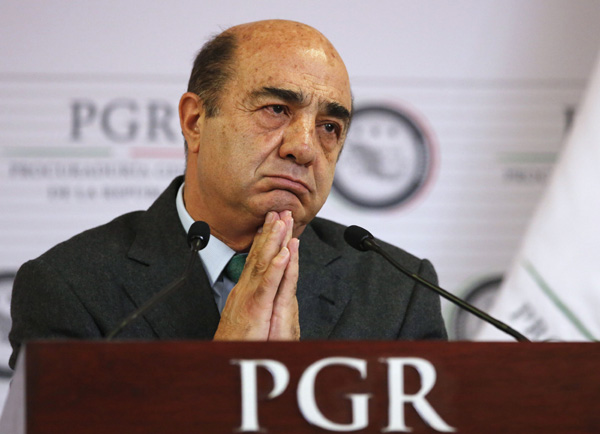Mexico: Investigation shows that all 43 students are dead
(Agencies) Updated: 2015-01-28 09:09
 |
|
Attorney General Jesus Murillo listens during a news conference at the attorney general's office in Mexico City January 27, 2015. [Photo/Agencies] |
Murillo Karam's explanation seemed unlikely to quell the controversy and doubts about the case, in which the federal government has been criticized for acting slowly and callously. Thousands of people demonstrated in Mexico City Monday night, demanding the students be returned alive.
The attorney general has come under attack from many quarters, including the students' relatives and fire experts, who say the government's version of what happened is implausible. Family members are still searching in hopes of finding the students alive.
The Argentine Forensic Anthropologists, an independent team hired by parents to work with federal investigators, said on Sunday that there is still not "sufficient evidence" to link the charred remains found by authorities in a river in the town of Cocula to what happened at the garbage dump.
Authorities say they were burned the night of Sept 26 and over the next day, and their incinerated remains were bagged up and thrown into a nearby river. The remains in the bags found in the river had traces of the garbage dump where the fire occurred, Murillo Karam added.
The scene of the crime was an 800-meter (yard) ravine that resembled a furnace, said criminal investigations chief Tomas Zeron.
So far 99 people have been detained in connection with the crime, including the former mayor of Iguala, Jose Luis Abarca.
Murillo Karam said the motive was that the members of a local gang, the Guerreros Unidos, believed the young men were rival gang members when they hijacked some public transit buses in Iguala. But many of the suspects testified that they knew the men were students. The students, known for commandeering buses and taking over toll booths to support their leftist causes, said they were taking the buses for transport to an upcoming demonstration in Mexico City.
- Mexico says murdered students were mistaken for rival gang
- Mexico to reveal rail bid winner in July
- China Telecom plans bid to build Mexico broadband network
- China group will build power plant in Mexico
- China Railway Construction re-bids for Mexico project
- Mexico reveals fresh bid terms for high-speed train
- Mexico to try wife of mayor linked to student disappearances
 When it comes to Africa, China's inroads are just getting started
When it comes to Africa, China's inroads are just getting started
When it comes to Africa, China's inroads are just getting started





